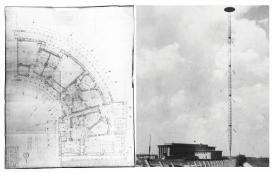In 1945, Soviet occupation troops made two important moves in German territory: they dismantled the single tallest structure standing in Europe, the Deutschlandsender III radio transmission tower; and they occupied the monumental building designed by Hans Poelzig, the Haus des Rundfunks, in Charlottenburg, West Berlin. Symbolically and technically important, these two maneuvers served as the prolegomenon for a radio war—what I will call the “ethereal war”—between the Eastern and Western bloc during the Cold War. The research I will be pursuing with the group “Epistemes of Modern Acoustics” studies the dialectically opposed, highly material face of this ethereal war. I propose to research the buildings, walls, transmission towers, factories, media industries, and territorial organizations that made it possible to produce, reproduce, and broadcast politically loaded media content across the Iron Curtain. A material understanding of Berlin’s radio apparatus during the Cold War period will likely reveal underresearched continuities between politics, technology, the media, and architecture, helping to reframe notions of monumentality, functionality, thresholds, and typology. At the same time, it will enable me to question the role of the building—and of the wall—in an age when the historic solidity of architecture was radically challenged by the entangled development of technology, politics, and the media industry, the latter taking the form of an ethereal medium: radio. Finally, it projects the same question into our own days, asking about the status of the building in our increasingly hyperconnected, apparently ubiquitous and invisible, presence.
This project is being developed as my doctoral dissertation and is supported by the Institute for the History and Theory of Architecture (GTA) at ETH Zurich.

